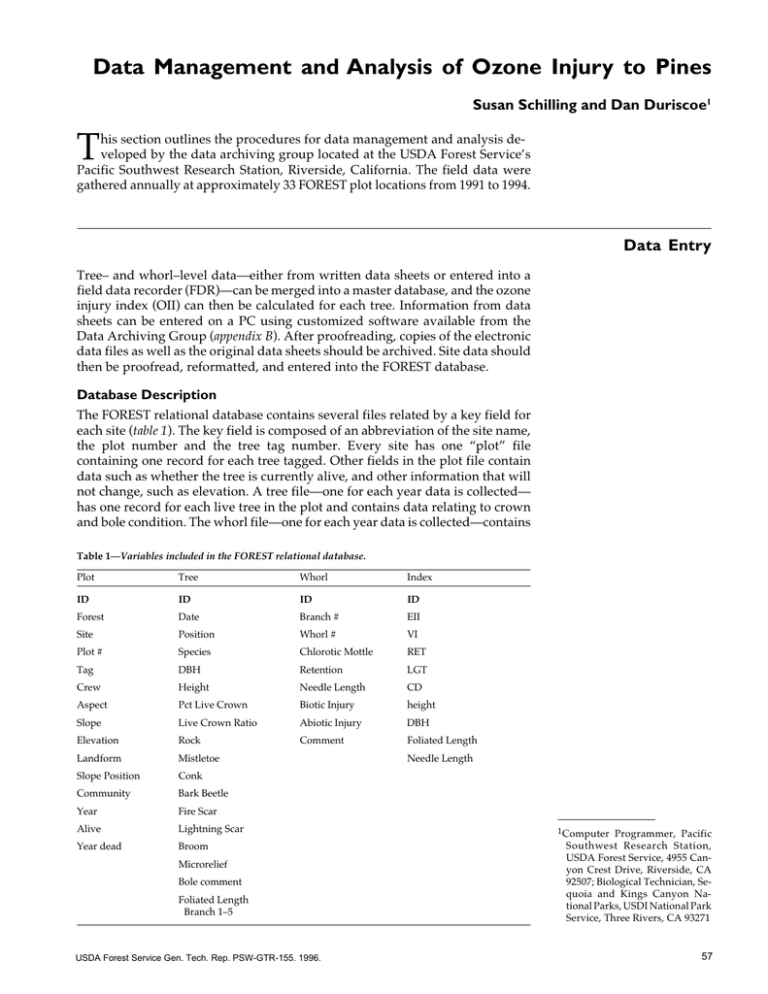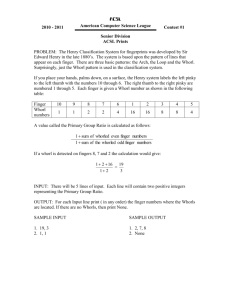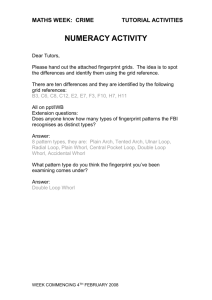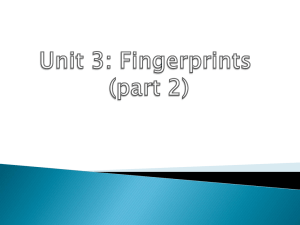T Data Management and Analysis of Ozone
advertisement

Data Management and Analysis of Ozone Injury to Pines
Schilling and Duriscoe
Data Management and Analysis of Ozone Injury to Pines
Data Management and Analysis of Ozone
Susan Schilling and Dan Duriscoe1
T
his section outlines the procedures for data management and analysis developed by the data archiving group located at the USDA Forest Service’s
Pacific Southwest Research Station, Riverside, California. The field data were
gathered annually at approximately 33 FOREST plot locations from 1991 to 1994.
Data Entry
Tree– and whorl–level data—either from written data sheets or entered into a
field data recorder (FDR)—can be merged into a master database, and the ozone
injury index (OII) can then be calculated for each tree. Information from data
sheets can be entered on a PC using customized software available from the
Data Archiving Group (appendix B). After proofreading, copies of the electronic
data files as well as the original data sheets should be archived. Site data should
then be proofread, reformatted, and entered into the FOREST database.
Database Description
The FOREST relational database contains several files related by a key field for
each site (table 1). The key field is composed of an abbreviation of the site name,
the plot number and the tree tag number. Every site has one “plot” file
containing one record for each tree tagged. Other fields in the plot file contain
data such as whether the tree is currently alive, and other information that will
not change, such as elevation. A tree file—one for each year data is collected—
has one record for each live tree in the plot and contains data relating to crown
and bole condition. The whorl file—one for each year data is collected—contains
Table 1––Variables included in the FOREST relational database.
Plot
Tree
Whorl
Index
ID
ID
ID
ID
Forest
Date
Branch #
EII
Site
Position
Whorl #
VI
Plot #
Species
Chlorotic Mottle
RET
Tag
DBH
Retention
LGT
Crew
Height
Needle Length
CD
Aspect
Pct Live Crown
Biotic Injury
height
Slope
Live Crown Ratio
Abiotic Injury
DBH
Elevation
Rock
Comment
Landform
Mistletoe
Slope Position
Conk
Community
Bark Beetle
Year
Fire Scar
Alive
Lightning Scar
Year dead
Broom
Microrelief
Bole comment
Foliated Length
Branch 1–5
USDA Forest Service Gen. Tech. Rep. PSW-GTR-155. 1996.
Foliated Length
Needle Length
1Computer Programmer, Pacific
Southwest Research Station,
USDA Forest Service, 4955 Canyon Crest Drive, Riverside, CA
92507; Biological Technician, Sequoia and Kings Canyon National Parks, USDI National Park
Service, Three Rivers, CA 93271
57
Data Management and Analysis of Ozone Injury to Pines
Schilling and Duriscoe
all the data collected from the whorls and has one record for each whorl. A
yearly OII index file is created from data in the tree and whorl files by the dBase
program, “Index.prg,” and contains the calculated OII for each live tree.
Development and
Application of the
Ozone Injury
Index (formerly
the Eridanus
Injury Index)
Index Components
The ozone injury index (OII) is a modified version of the additive Eridanus
injury index (EII) proposed by Duriscoe (1988), and is comprised of the primary
effects of ozone air pollution on pines:
• Production of chlorotic mottle symptoms;
• Accelerated senescence of needles and subsequent reduced whorl
retention from ozone stress that also reduces the amount of carbon
fixation;
• Reduced percent live crown as lower branches die first in ozone
declining trees;
• Reduced needle length in newly initiated needles as carbon reserves
become limiting (Miller and others 1963).
Whorl retention is weighted 40 out of 100; mottle is weighted 40 out of 100;
needle length is weighted 10 out of 100; and live crown ratio is rated 10 out of
100. The OII incorporates the degree of pollution injury at the branch level to
give a tree level score. The maximum injury score is 100 and indicates a tree that
has only one whorl of needles remaining, greater than 40 percent chlorotic
mottle injury on that whorl, short needles (1 centimeter or less), and a percent
live crown of less than 10 percent. The minimum index score is zero and
indicates a tree with no chlorotic mottle symptoms on any of the foliage (an
asymptomatic tree): if no chlorotic mottle is found on any needles, i.e., if the
chlorotic mottle factor is zero, then reductions in whorl retention, live crown
ratio, and needle length cannot be attributed to ozone air pollution. Therefore,
these factors are not computed and the composite OII is set to zero for
asymptomatic trees regardless of condition of the crown.
The index weights whorl retention (40 percent) and chlorotic mottle (40
percent) greater than the other index components—percent live crown (10
percent), average needle length (10 percent)—and is therefore not strictly
monotonic (if an index is not strictly monotonic there should be a valid reason
for increased emphasis on any one factor) (Muir and McCune 1987). The
increased emphasis on whorl retention and mottle is based on physiological
studies by Patterson and Rundel (1989). Their work also indicates that all
whorls are significant contributors of fixed carbon. Thus, the index fulfills the
requirements elucidated by Muir and McCune (1987) for assessing pollution
injury on vascular plants.
Caveats
Chlorotic mottle has a relatively linear effect in reducing net photosynthesis of
Jeffrey and ponderosa pine to about 40 percent of needle surface. After 40
percent of the surface area is affected, increasing levels of mottle on
photosynthesis is negligible (Patterson and Rundel 1989). Therefore, when the
visible injury ratings of the whorls are averaged for a branch, all ratings above
three are set to three. If no chlorotic mottle is present on any whorl, the injury
index is zero. Mottle injury is also weighted by the whorl on which it occurs. If
only two whorls are present on a branch the mottle rating from each is weighted
58
USDA Forest Service Gen. Tech. Rep. PSW-GTR-155. 1996.
Data Management and Analysis of Ozone Injury to Pines
Schilling and Duriscoe
equally. If there are three whorls the mottle is weighted, .35, .35, .30 for the first,
second, and third whorls, respectively. If the branch has four or more whorls,
the mottle is weighted .28, .28, .24, .20 for the first to fourth whorls. Mottle
appearing on a fifth or older whorl does not contribute to the index and is used
only to delineate a symptomatic/asymptomatic branch. The maximum mottle
score is 40, the minimum score is zero (a mottle injury score of zero implies an
overall OII of zero).
Whorl retention evaluation assumes that retention of five annual whorls
indicates a healthy ponderosa pine (Munz and Keck 1973). Although Jeffrey
pines can be expected to retain eight or more whorls, the use of five as a
threshold for ozone effects is reasonable since retention of more than five
whorls indicates a relatively healthy pine tree. If a pine has chlorotic mottle on
whorls five or older the mottle factor of the injury index will indicate the tree is
asymptomatic, and the whorl retention factor of the index will record no injury.
A pine is not likely to be even moderately impacted if it retains more than five
whorls of needles. Whorl retention, and percentage of fascicles retained per
whorl (1 = 1–33 percent; 2 = 34–66 percent; 3 = 67–100 percent), are scored on the
data sheet to indicate missing whorls or portions of missing whorls because of
insect predation, fungi, or other stresses (non–air pollution causal agents). The
index computes whorl retention as fractions of whole whorls (i.e., 1, .66, .33),
except for less than one whorl retention. Branches with less than one whorl are
considered to have a full whorl in the index, since retention of 1 whorl or less
produces the maximum injury score (40) for whorl retention (see example below).
Maximum injury score for whorl retention is 40 (only one whorl of needles),
minimum score is 0 (five or more full whorls of needles).
Modal needle length in centimeters of representative needles is measured
in the middle of each year’s whorl of needles. This assumes that maximum
expansion of the needle has occurred and that the needle length of a very
healthy ponderosa is 21 centimeters and Jeffrey pine needle is 19 centimeters.
Needle lengths shorter than one centimeter are computed as one centimeter.
Maximum injury score for needle length is 10 (needles 1 centimeter or less),
minimum score is 0 (needles 21 or 19 centimeters or greater).
Percent live crown is the proportion of the total crown that has any live
branches with any number of live needles. This assumes a crown retention of 10
percent as a minimum value. Maximum injury score for percent live crown is 10
(10 percent or less of the bole with a live branches), minimum score is 0 (80
percent or more of bole with live branches).
Definitions and Weightings
Each of the following four variables require individual calculation before
summation. These calculations provide averaging and introduce the specified
weightings.
Equation for
Calculating the
Ozone Injury
Index (OII)
OII = VI + RET + LGT + CD
in which:
VI = Visible injury (chlorotic mottle)
RET = Number of needle whorls present and fascicle retention
LGT = Modal length of needles (average all whorls)
CD = Percent live crown
USDA Forest Service Gen. Tech. Rep. PSW-GTR-155. 1996.
59
Data Management and Analysis of Ozone Injury to Pines
Schilling and Duriscoe
Visible injury (VI) (chlorotic mottle)
VI includes weighted average of up to the first four whorls:
5+ Whorls: VI=1+{40*((CM1*.28)+(CM2*.28)+(CM3*.24)+(CM4*.20))/3}
4 Whorls: VI=40*((CM1*.28)+(CM2*.28)+(CM3*.24)+(CM4*.20))/3
3 Whorls: VI=40*((CM1*.35)+(CM2*.35)+(CM3*.30))/3
2 Whorls: VI=40*((CM1*.50)+(CM2*.50))/3
1 Whorl : VI=40*(CM1)/3
in which:
CM1 (chlorotic mottle) is the average mottle on all current year whorls (except if
mottle rating of a whorl is > 3 it is set to 3 before average is calculated). CM2 is
the average mottle on all one–year–old whorls, and so on.
Retention (RET)
If oldest whorl on any branch is 1:
FWHORL=WR1*.33
If oldest whorl on any branch is 2–6:
FWHORL=(oldest whorl–2)+(sum fascicle retention 2 oldest whorls*.33)
If oldest whorl on any branch is > 6:
FWHORL = oldest whorl – 1
Then:
RET = 40*[100.37/(1+e^(1.72*(FWHORL–4.532)))+.6304]/100
in which:
e=2.718
WR1=Average fascicle retention of all current year whorls on all 5
branches.
WR2=Average fascicle retention of all 1–year–old whorls on all 5 branches.
WR3=Average fascicle retention of all 2–year–old whorls on all 5 branches.
Needle length (LGT)
If species is Jeffrey pine:
LGT=(18–Len)*10/18
If species is ponderosa pine:
LGT=(21–Len)*10/21
in which:
Len is the average needle length of all whorls.
60
USDA Forest Service Gen. Tech. Rep. PSW-GTR-155. 1996.
Data Management and Analysis of Ozone Injury to Pines
Schilling and Duriscoe
Percent live crown (CD)
CD=(80–percent live crown)*10/70
OII Calculation
Sample Data Set for One Tree
BRANCH
WHORL
CM
RET
NL
1
1
0
3
20.5
1
2
0
3
17.5
1
3
0
3
21.0
1
4
1
1
13.0
2
1
0
3
17.0
2
2
0
3
18.5
2
3
0
3
20.0
2
4
5
3
14.0
3
1
0
3
16.5
3
2
0
3
17.5
3
3
0
3
21.0
3
4
1
2
11.5
4
1
0
3
21.0
4
2
0
3
20.0
4
3
0
3
20.0
4
4
1
2
15.0
4
5
0
0
0
4
6
2
1
15.0
5
1
0
3
18.0
5
2
0
3
17.0
5
3
1
3
19.0
5
4
1
1
13.0
5
5
0
0
0
5
6
0
1
13.0
(This whorl is missing)
(This whorl is missing)
Weighting of Components and Computation of the OII
Chlorotic mottle
Oldest whorl is 6
CM1=(0+0+0+0+0)/5 = 0
CM2=(0+0+0+0+0)/5 = 0
CM3=(0+0+0+0+1)/5 = .2
CM4=(1+3+1+1+1)/5 = 1.4
VI=1+{40*[(0*.28)+(0*.28)+(.2*.24)+(1.4*.20)]/3}=5.37
USDA Forest Service Gen. Tech. Rep. PSW-GTR-155. 1996.
61
Data Management and Analysis of Ozone Injury to Pines
Schilling and Duriscoe
Retention
Oldest whorl is 6
Fascicle retention of two oldest whorls is:
WR5 = 0
WR6 = (0+0+0+1+1)/5 = .4
FWHORL = (6–2)+((0+.4)*.33)]} = 4.132
RET = 40*[100.37/(1+2.718^(1.720*(4.132-4.532)))+.6304]/100
= 26.97
Needle length
LEN=17.2, Species is ponderosa
LGT=(21–17.2)*10/70 = 1.81
Percent live crown
Percent live crown = 66
CD=(80–66)*10/70 = 2
Result
OII=VI+RET+LGT+CD = 5.37 + 26.97 + 1.81 + 2.0 = 36.15
62
USDA Forest Service Gen. Tech. Rep. PSW-GTR-155. 1996.






